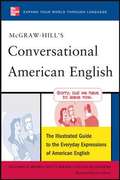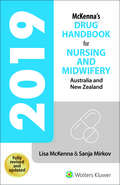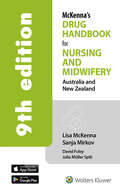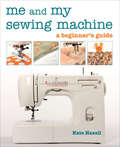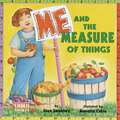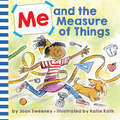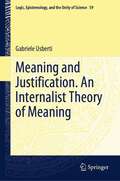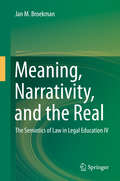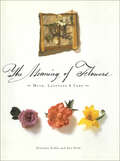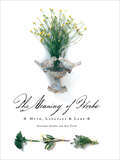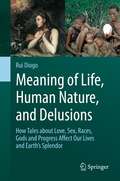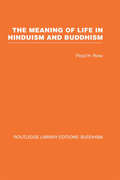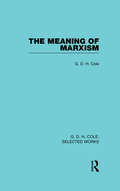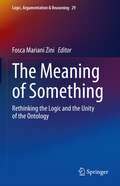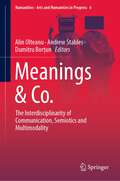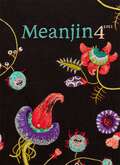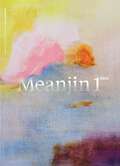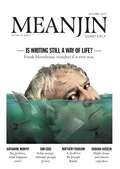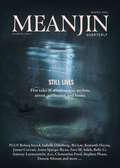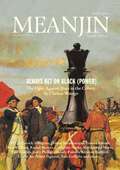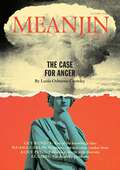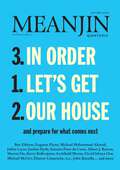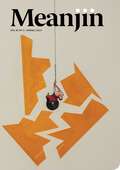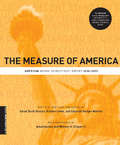- Table View
- List View
McGraw-Hill's Conversational American English: The Illustrated Guide to the Everyday Expressions of American English
by Richard A. Spears Betty J. Birner Steven Racek Kleinedler Luc NissetAs a new speaker of English, you may hear some expressions in your daily conversations that you do not understand--yet. McGraw-Hill's Conversational American English will help you learn these expressions, so not only do you know what a person is saying to you, but that you can use the expression yourself! More than 3,000 expressions are organized by theme, so you can find what you are looking for quickly. And each topic is illustrated to further help you understand context. The book features: Common expressions are batched into 350 themes, ranging from general greetings and asking how someone is, to the more specific needs, like showing disbelief, asking someone's intentions, and expressions for a forgotten word or name A comprehensive thematic glossary provides an additional means for the learner to locate expressions by key words and concepts Topics include: Basic Social Encounters, Greetings, Small Talk, Introductions, Ending a Conversation, Good-Byes, Agreeing, Disagreeing Conversational Encounters, Focusing Attention, Launching the Conversation, Making Friends, Complex Matters, Disputes, Discussion and Resolution, Polite Encounters, Prefaces, Communication Barriers
McKenna’s Drug Handbook for Nursing and Midwifery 2019
by Lisa McKenna Sanja MirkovNever miss out on the latest drug information, on the ward or in the classroom, with this fully revised and updated handbook for nurses and midwives. If you’re an educator, be confident your students have all they need to safely administer the latest drugs, using the latest protocols and best-practice guidelines. If you’re a student or professional, be sure you can search for drug information relevant to you, on the go, when and where you need it. Contains revised information on over 1100 essential drugs, for patients of all ages and categories. It’s never been easier to keep up. Whats NEW? Updated every year Keep up with new drugs Comes as an app Search on the go Ebook included Search how it suits you NZ-only drugs clearly marked Relevant to you
McKenna’s Drug Handbook for Nursing & Midwifery: Australia & New Zealand
by Lisa McKenna Sanja Mirkov David Foley Julia Mueller SpitiNever miss out on the latest drug information, on the ward or in the classroom, with this fully revised and updated handbook for nurses and midwives. If you’re an educator, be confident your students have all they need to safely administer the latest drugs, using the latest protocols and best-practice guidelines. If you’re a student or professional, be sure you can search for drug information relevant to you, on the go, when and where you need it. Contains revised information on over 1100 essential drugs, for patients of all ages and categories. It’s never been easier to keep up. Whats NEW? Updated regularly Keep up with new drugs Comes as an app Search on the go Ebook included Search how it suits you NZ-only drugs clearly marked Relevant to you
Me and My Sewing Machine: A Beginner's Guide
by Kate HaxellThis jargon-free, fully illustrated guide to using your sewing machine explains essential techniques and offers easy projects for getting started. Straightforward and accessible, Me and My Sewing Machine contains everything you need to know to get the most out of your sewing machine. There are no intimidating specialty techniques, painstaking procedures, or complicated methods. Instead you will find easy-to-understand, practical and decorative techniques that make sewing simple, even if you have never used a machine before. Author and professional crafter Kate Haxell shares clever tips and shortcuts, as well as advice on when you can use these speedy methods and when it really is better to do something the traditional way. Everything is illustrated with step-by-step photography and finished samples. Haxell also includes easy sewing projects that are simple without skimping on style.
Me and the Measure of Things
by Joan SweeneyThe energetic narrator of Me Counting Time and Me on the Map is back, this time introducing young readers to the units of measure. What’s the difference between a cup and an ounce? What gets measured in bushels and when do you use a scale? Easy-to-understand text and playful corresponding illustrations teach children the differences between wet and dry measurements, weight, size, and length. And all information is conveyed in a unique kid’s-eye perspective, using everyday objects and situations. Me and the Measure of Things makes measurement fun–and comprehensible!
Me and the Measure of Things
by Joan SweeneyNow with new art by Katie Kath (illustrator of Unusual Chickens for the Exceptional Poultry Farmer), this easy-to-understand introduction teaches children how to quantify the things in their daily routines. They'll learn all about the tools they need to measure--rulers, scales, pencils, and cups--as well as the language to express what they find. Readers will soon have the answers to their questions--how far, how tall, and how small? Me and the Measure of Things joins the other repackages in Joan Sweeney's popular Me...series--Me on the Map, Me and My Place in Space, Me and My Amazing Body, Me and My Family Tree, Me Counting Time, and Me and My Senses.
Meaning and Justification. An Internalist Theory of Meaning (Logic, Epistemology, and the Unity of Science #59)
by Gabriele UsbertiThis volume develops a theory of meaning and a semantics for both mathematical and empirical sentences inspired to Chomsky’s internalism, namely to a view of semantics as the study of the relations of language not with external reality but with internal, or mental, reality. In the first part a theoretical notion of justification for a sentence A is defined, by induction on the complexity of A; intuitively, justifications are conceived as cognitive states of a particular kind. The main source of inspiration for this part is Heyting’s explanation of the intuitionistic meaning of logical constants.In the second part the theory is applied to the solution of several foundational problems in the theory of meaning and epistemology, such as Frege’s puzzle, Mates’ puzzle about synonymy, the paradox of analysis, Kripke’s puzzle about belief, the de re/de dicto distinction, the specific/non-specific distinction, Gettier’s problems, the paradox of knowability, and the characterization of truth. On a more general philosophical level, throughout the book the author develops a tight critique of the neo-verificationism of Dummett, Prawitz and Martin-Löf, and defends a mentalist interpretation of intuitionism.
Meaning, Narrativity, and the Real
by Jan M. BroekmanThis book examines the concept of meaning and ourgeneral understanding of reality in a legal and philosophical context. Startingfrom the premise that meaning is a matter of linguistic and other forms ofarticulation, it considers the inherent philosophical consequences. PartI presents Klages', Derrida's, Von Hofmannsthal's and Wittgenstein'sexplorations of silence as a source of articulation and meaning. Debatesabout 20th century psychologism gave theattitude concept a pivotal ro≤ it illustrates the importance of the discoverythat a word is globally qualified as 'the basic unit of language'. Thisis mirrored in the fact that we understand reality as a matter of particles andthus interpret the real as a component of an all-embracing 'particle story'. Each chapter of the book focuses on an aspect of legal semiotics relatedto the chapter's theme: for instance on the meaning of a Judge's 'Saying forLaw', on law students training in varying attitudes or on the ties between lawand language. Part II of the book illustrates our generalunderstanding of reality as a matter of particles and partitioning, andexamines texts that prove that particle thinking is basic for our meaningconcept. It shows that physics, quantum theory, holism, and modern brainresearch focusing on human linguistic capabilities, confirm their ties to theparticle story. In contrast, the book concludes that partitions and particlesare neither a fact in the history of the cosmos nor a determinant of knowledgeand the sciences, and that meaning is a process: a constellation rather than afixation. This is manifest once one understands meaning as the result ofcontinuously changing attitudes, which create our narratives on cosmos andcreation. The book proposes a new key for meaning: a linguistic occurrenceanchored in dimensions of human narrativity.
The Meaning of Flowers: Myth, Language & Lore
by Gretchen Scoble Ann FieldA colorful primer to the symbolism and lore from around the world for over sixty flowers to help you add meaning to any floral gift.Should you send a rose of crimson or of white to the one you love? What gift of flowers best expresses thanks to a dear friend? From ancient days, long before words complicated what we say to one another, flowers have been our messengers, invested with our most cherished feelings.Illustrated with luscious collages by acclaimed artist Ann Field, this enchanting tribute to the power and symbolism of flowers offers a contemporary introduction to an age-old tradition. The text draws on botanical, historical, and mythological sources worldwide, from ancient Rome to Victorian England, from Asia to the Americas, presenting portraits of over sixty blossoms favored for all time. In Persia, for instance, the black medulla of the red tulip was said to represent the lover’s heart, burnt to a coal by love’s passion. To Victorians, lavender signified a broken trust, hollyhocks fertility, and nasturtiums a jest or whimsy.Blending fact, folktale, natural history, and original art, The Meaning of Flowers explores the language and lore of nature’s most intimate and beautiful gifts.
The Meaning of Herbs: Myth, Language & Lore
by Gretchen Scoble Ann FieldThe fascinating history and uses of these versatile botanicals through the ages, from love potions to self-care—from the authors of The Meaning of Flowers. &“Take borage for courage. Send a bouquet of yarrow to declare war. Hang a sprig of rue at the door to keep witches at bay.&” Like flowers, herbs are steeped in myth and magic, secrets and lore. For centuries, their powers have been called upon to seduce lovers and dispel witches, send hidden messages and brew potent elixirs, entice the palate and soothe the mind. Illustrated with enchanting collages by acclaimed artist Ann Field, this delightful tribute to the meaning and magic of herbs offers a contemporary introduction to an age-old tradition. The text draws on botanical, mythological, and historical sources worldwide, from ancient Rome to Victorian England, from Asia to the Americas, presenting profiles of over fifty herbs favored through the ages. Blending fact, folktale, natural history, and original art, The Meaning of Herbs explores the language and lore of nature&’s most versatile and powerful gifts.
Meaning of Life, Human Nature, and Delusions: How Tales about Love, Sex, Races, Gods and Progress Affect Our Lives and Earth's Splendor
by Rui DiogoWhatever are your beliefs, background, education, political views or interests, one thing is sure: this book will engage you, teach you something new, and more importantly make you to re-think deeply about critical aspects of your daily-life, including sex, love, food, physical activities, diseases, work and stress, and how you see and deal with other people, other animals, and the planet in general. Indeed, it focuses on topics that have fascinated people from all places and historical periods since times immemorial: Why are we here? What is the meaning of life? Are we progressing, and will we thrive? It does this by integrating in a unique fashion information from ancient Greek, Sumerian, Hindu, Jewish, Buddhist, Christian and Muslim texts to high-tech brain research, facts about near-death experiences, Covid-19, QAnon conspiracies, virtual reality and dating aps; from Adam and Eve to the rise of misogyny and racism to Black Lives Matter, Me-Too, Hollywood romantic movies and Disney fairy-tales. Contrary to notions about 'human progress' and 'Homo Deus' defended by authors such as Harari, Pinker and Dawkins, it shows that human history instead involves the repetition of similar imaginary tales created by a combination of traits found in other animals and the uniquely human obsession about 'cosmic purpose' stories related to our awareness of death's inevitability. Organized religions appeared later, chiefly during the rise of agriculture and 'civilizations'. Diogo navigates mesmerizing untold stories revealing a paradox: these events and the industrial 'revolution' increased inequality, oppression, slavery, subjugation of women, famines, plagues, 'work', stress, and suicides. Data from psychology, biology, neurobiology, and cross-cultural studies of hunter-gatherers and so-called 'developed' societies reveal an even more profound paradox: within all forms of life, the 'sapient being' is the one immersed in Neverland's world of unreality - truly a Homo irrationalis, fictus and socialis believing in fictional tales about cosmic 'duties', 'romantic meant to be', demons, inferior 'races' and 'genders', conspiracies, and 'justified' slavery, warfare, genocides, and animal abuses. Importantly, such tales play, on the other hand, crucial functions such as help coping with death and a plethora of societal troubles, decreasing stress, or preventing drug and alcohol abuse. An optimist and passionate wondered and wanderer, Diogo provides enthralling details about the history of religion, discrimination, romantic love, warfare, diseases and Earth's biodiversity illustrating how 'virtue is in the middle' and that we - with our intriguing combination of beliefs, bodily needs and desires, artistic abilities, and mismatches between our senses' illusions and the cosmos' reality - are not 'better' or 'worse' than the other millions of captivating living species. This powerful and urgently needed message has critical repercussions for how we understand, care about, and mindfully enjoy living in this splendid planet, in the reality of here and now.Pre-publication comments: "I applaud the enormous work that Diogo has invested in this follow-up to his widely acclaimed Evolution driven by organismal behavior book, and the challenge of getting people to think beyond and outside of our usual set of definitions and expectations. The case-studies provided in the book are fascinating and insightful" (Drew Noden, Award-winning Emeritus Professor, Cornell University)"Rui Diogo is becoming the Slavoj Zizek of evolutionary biology" (Marcelo Sanchez-Villagra, Director of the Paleontological Institute and Museum of the University of Zurich)
The Meaning of Life in Hinduism and Buddhism (Routledge Library Editions: Buddhism)
by Floyd H RossOriginally published in 1952. This volume, by discussing significant insights of Hinduism and Buddhism, answers the question "What is the meaning of life?" It illustrates the importance of Buddhist and Hindu teachings and their relevance to the West, as well as clarifying some of the religious and philosophical problems Western readers must grapple with.
The Meaning of Marxism (Routledge Library Editions)
by G. D. ColeThis book is largely based on What Marx Really Meant which was written by Cole and published in 1934. It is a revaluation of Marx's essential ideas and methods in relation to contemporary social structures and developments and considers the bearing of Marx's theories on the structure of social classes, which altered greatly since he formulated his account of them.
The Meaning of Something: Rethinking the Logic and the Unity of the Ontology (Logic, Argumentation & Reasoning #29)
by Fosca Mariani ZiniThis innovative volume investigates the meaning of ‘something’ in different recent philosophical traditions in order to rethink the logic and the unity of ontology, without forgetting to compare these views to earlier significative accounts in the history of philosophy. In fact, the revival of interest in “something” in the 19th and 20th centuries as well as in contemporary philosophy can easily be accounted for: it affords the possibility for asking the question: what is there? without engaging in predefined speculative assumptions The issue about “something” seems to avoid any naive approach to the question about what there is, so that it is treated in two main contemporary philosophical trends: “material ontology”, which aims at taking “inventory” of what there is, of everything that is; and “formal ontology”, which analyses the structural features of all there is, whatever it is. The volume advances cutting-edge debates on what is the first et the most general item in ontology, that is to say “something”, because the relevant features of the conceptual core of something are: non-nothingness, otherness. Something means that one being is different from others. The relationality belongs to something.: Therefore, the volume advances cutting-edge debates in phenomenology, analytic philosophy, formal and material ontology, traditional metaphysics.
The Meaning of Tingo
by Adam Jacot de BoinodDid you know that people in Indonesia have a word that means 'to take off your clothes in order to dance'? Or how many words the Albanians have for eyebrows and moustaches? Or that the Dutch word for skimming stones is plimpplamppletteren? Drawing on the collective wisdom of over 154 languages, this intriguing book is arranged by theme so you can compare attitudes all over the world to such subjects as food, the human body and the battle of the sexes. Here you can find not only those words for which there is no direct counterpart in English (such as the Japanese age-otori which means looking less attractive after a haircut), but also a frank discussion of exactly how many 'Eskimo' terms there are for snow, and a vast array of information exploring the wonderful and often downright strange world of words. Oh, and tingo means 'to take all the objects one desires from the house of a friend, one at a time, by asking to borrow them'.
Meanings & Co.: The Interdisciplinarity of Communication, Semiotics and Multimodality (Numanities - Arts and Humanities in Progress #6)
by Alin Olteanu Andrew Stables Dumitru BorţunThis book explores the interdisciplinarity of semiotics and communication studies, comprising both theoretical explorations and semiotic applications to communication with theoretical bearings. These disciplines have generally been understood as mutually implicit, but there still are many unexplored research avenues in this area, particularly on a conceptual level. The book offers broad insights into the epistemological relations between semiotics and other approaches to communication from perspectives such as sociology, philosophy of language and communication theory. As such, it sheds light on the communication of knowledge.Semiotics is currently enjoying increasing popularity within the humanities and social sciences. Understood as relational logic (Charles Peirce) or hermeneutics (structuralism and poststructuralism), semiotics fundamentally implies certain positions with regard to communication. Because of the generality and conceptual vagueness of semiosis and communication, how one elucidates the other is still an underexplored theme. With some pioneering studies of this relation, the books examines various fields, such as language, code, learning, embodiment, political communication, media, cinema, cuisine, multimodality and intertextuality.
Meanjin Vol 72, No 4
by Meanjin QuarterlyHelen O'Neil takes us inside the development of Labor's long-awaited Cultural Policy, and the future of the policy under a new government. Rebecca Harkins-Cross brings us the first in a series on new media art in Australia with an essay looking at the revolutionary ways Indigenous Australian artists are using video. Jennifer Mills quits poetry and ponders the peculiar life of the self-declared poet while Rebecca Giggs takes us into the wide blue yonder in pursuit of a mysterious giant eyeball. Lesley Harding and artist Rebecca Mayo walk the Merri Creek wearing some very special garments and Hilary McPhee undertakes the fraught process of archiving the past. Journalist Jill Jolliffe contemplates her eventful visits to war-torn Angola in the early 1990s and Ellena Savage takes us to Bougainville and an uneasy adjustment to tropical living. There's new fiction from Briohny Doyle, Mireille Juchau and Anika Quayle and sparkling poetry from Eileen Chong, Elizabeth Lawso, Chris Mansell, Kate Middleton and many more.
Meanjin Vol 73, No 1
by Meanjin QuarterlyThe March 2014 issue of Meanjin is full of outsiders, revolutionaries and dissenters. We discover a lost archive of photographs of Charmian Clift on and George Johnson on Hydra in an essay by Paul Genoni and Tanya Dalziell, while James Douglas take a look at the unique powers of persuasion employed by journalist and writer Anna Krien. In the Meanjin Papers essay, Paul Daley brings us the shocking history of Australia's unidentified Indigenous remains and we have a rich mix of memoir, fiction and poetry in this special bumper issue.
Meanjin Vol 76, No 1
by Meanjin QuarterlyThe writer's life ... it's not an easy one. In the autumn issue of Meanjin Australian literary giant Frank Moorhouse describes the often-difficult path followed by those hardy souls who take 'the writer's oath'. For the man behind Days of Wine and Rage, Forty Seventeen, Dark Palace and the rest of the soon-to-be televised 'Edith Trilogy', it has been a lifelong journey studded with many books, prizes and much acclaim. Material rewards were never sought and perhaps that's for the best, for the writer's life is not a richly rewarded one. Moorhouse has some thoughts on how that might change. Our moment in politics is nothing if not fascinating and regular Meanjin essayist Katharine Murphy wonders just where politics might take us next (and here's a clue: she's not really sure). Tasmanian writer Ben Walter walks through the singed and sodden Tarkine and finds an ancient eco-system in eerie flux. Dan Cass details the increasing democratisation of the power that fuels our homes ... cheap solar is here, and nothing will ever be the same. There's fresh fiction from Jennifer Mills, Laura McPhee-Browne and more, a fine crop of new poetry and memoir that moves from bruising violence to wistful stargazing.
Meanjin Vol 80, No 2
by Meanjin Quarterly'The world knows that the Australian immigration process is very tough.' In the magazine's cover feature Still Lives, five people now resident in Australia and New Zealand tell in vivid first-hand accounts the stories of lives stilled by statelessness or detention, and lives settled in a new home and a sense of belonging. Their stories are matched with luscious images by artist Sarah Walker. Anna Spargo-Ryan looks at recent cases of sexual harassment and violence in and around the national parliament and concludes 'This government cannot deliver action on sexual violence. They have told us to our faces: they simply do not understand how.' Mark Pesce considers the recent battles between the Australian Government and the world's major players in social media and the online world, an epoch-defining clash, he argues, between state sovereignty and technological monopoly. Historian James Curran has a long conversation with that legend of well-chosen Australian letters, Don Watson. In the first of two pieces looking at allegations of war crimes made against Australian soldiers in Afghanistan, Bobuq Sayed argues that 'The war crimes detailed by the Brereton Report are endemic to a growing culture of white supremacy in Australia that has also clearly taken root in the ADF.' Caroline Graham looks at the very long history of 'regrettable incidents' involving Australian soldiers, a story of 'warriors, bad apples and blood lust'. Plus: Clementine Ford on women's anger, Tom Griffiths on the great environmentalist and walker John Blay, Sara Saleh considers Australia in Three Books, Dennis Altman and Alistair Kitchen give two perspectives on 'cancel culture', and Kenneth Hayne writes on our troubled institutions. New fiction from Bri Lee, Bella Li, Shannon Burns and Jocelyn Richardson. New poetry from pO, Rebecca Jessen, John Kinsella, Graham Akhurst, Jennifer Maiden, Helene Pantsis, Cailin Maling, Liam Ferney, Aidan Coleman, Jane Downing, Geoff Page, Tracy Ryan and Derek Chan. A review section featuring Zowie Douglas-Kinghorn, Mindy Gill, Raelee Lancaster, Gabriella Munoz and Stephen Pham.
Meanjin Vol 80, No 3
by Meanjin Quarterly'I've never been too impressed with the metaphoric mountain-top that Black race scholars and civil rights activists have typically been concerned with, of a promised land and a dream . . . As appealing as it sounds I don't believe that such a world will ever be possible in a settler colonial state . . . The place that they have built for themselves was established and is sustained by racial violence, and all of their institutions are unrelenting in their viciousness towards sovereign Black bodies.' In September Meanjin, Queensland academic, Munanjahli and South Sea Islander woman Chelsea Watego writes powerfully on the necessity of 'walking away' from colonial institutions and constructs, in order to find the truth of individual and collective power as an Indigenous Australian. It is, she argues, a fight against the very notion of race itself: 'We must stand in our own power, for it is only in knowing ours that we know the false claims of theirs. This is black power.' Patrick Allington writes on how Swedish artist Hilma af Klint 'has intruded upon my inner world and become a sort of guiding light'. Amal Awad surveys the world of romance novels for signs of orientalism and 'sheikh-lit'. Tom Griffiths paints a lingering portrait of the 'humble Australian bushman', John Blay, writer, walker, advocate of the natural world. Yumna Kassab writes on colonialism, conquest, occupation and dispossession: the modern Australian story. Plus: Ron Radford on the early colonial art in Tasmania, Prithvi Varatharajan on literary engagements with the non-human world, Rachel Weaver on currawongs, plus other essays from Carly Stone, Jacqui Shelton, Kath Kenny, Tim Dunlop and more. New fiction from: Kristian Radford, Jo Langdon, Mohammed Massoud Morsi, Hollen Singleton and Rose Allan. New poetry from: Marina Hazard, Andrew Sant, Anthony Lynch, Wen-Juenn Lee, Carl Walsh and more. Reviews include Melody Paloma on Evelyn Araluen's Dropbear, Scott Limbick on Martin McKenzie-Murray's The Speechwriter and Mira Schlosberg on Melissa Broder's Milk Fed.
Meanjin Vol 81, No 1
by Meanjin Quarterly' . . . embracing anger is a political act. This is not a personal project but a social one-being passive and perpetually afraid of your power reinforces the status quo, and I am no longer interested in that. Anger is a complex emotion, which is exactly why my child-brain suppresses it, and exactly why we as a society are afraid of it. Anger teaches us that not everything has to be either/or.' In a profound and personal essay, Lucia Osborne-Crowley writes on learning to embrace anger as a multi-faceted emotion. Anger can be an act of caring, anger can be a force for personal power, and inter-personal good; anger, she says, 'can sit alongside love and hope and connection rather than being their opposite.' Guy Rundle studies the rise of the Knowledge Class, the laptop tapping workers at the core of the west's new economy, and details the challenge - and opportunity - this growing group poses for traditional progressive politics. Na'ama Carlin found her first pregnancy challenging, a minefield of existential and practical complication. Then she was diagnosed with aggressive breast cancer. Author Alice Pung writes on the vexed politics of 'diversity' in the Australian publishing industry. Futurist Mark Pesce is anxious about the social implications of the Facebook 'metaverse', but that's just the tip of the iceberg. Critic and curator Chris McAuliffe looks at the hidden and very complicated history of the Australian flag. El Gibbs writes on the hidden pandemic: of living with both covid and disability. Other essays from Declan Fry, Martin Langford, Gemma Carey, Madeleine Gray, Jill Giese, Bruce Buchan and more. Memoir from Alice Bishop, Alexander Wells, Dominic Gordon and Hannah Preston. New fiction from Jennifer Mills, Ouyang Yu and Christopher Raja. New poetry from Adam Aitken, Lucy Dougan, Ashleigh Synnott, Stephen Edgar, Svetlana Sterlin, Junie Huang and more. Reviews from Millie Bayliss, Imogen Dewey, Hasib Hourani, Thabani Tshuma and Rosie Ofori Ward.
Meanjin Vol 82, No 1
by Meanjin QuarterlyLight, air and the autumn wind. Good drying weather. Ethics and history and peace and war and the laundry. Taking stock. Abandoned cities, lost children, political legacies emptied of all honour. ???????????. How we commemorate, and what we forget. The cost of education, the cost of living, the costs of doing nothing. Insects, birds, bulls, deer, saplings, forests, the Great Barrier Reef. Ethical beekeeping, hydrogeology, the second person. Ruin porn and inspiration porn. Solar Punk and Chengyu and the Argonauts. Housing and home, love and Metta, class and compassion. Understanding where it is that we exist when we're gathering our forces. Let's get our house in order - and prepare for what comes next.
Meanjin Vol 82, No 3
by Meanjin QuarterlyGuest-Edited by Bridget Caldwell-Bright and Eugenia Flynn, Meanjin 82.3 Spring 2023 is the first edition in the venerable journal's 83-year history to be devoted entirely to the work of Aboriginal and Torres Strait Islander writers and artists. The Meanjin Paper that opens this special edition is an archival interview with Oodgeroo Noonuccal, followed by a State of the Nation piece by Gary Foley, and an interview with Ali Cobby-Eckermann. There are essays by Gregory Phillips, Tristen Harwood, Apryl Day, Celeste Liddle and Davina B Woods; fiction by Tony Birch, Melanie Saward, Jeanine Leane and Jasmin McGaughey; memoir by Anna Wommatakimmi, Rosa Flynn-Smith and Phillip Bell; critical culture pieces by Ali Gumillya Baker, Paola Balla and Philip Morrissey; experimental work by Paul Collis and Wayne Knight (with Jen Crawford and Paul Magee). There's also poetry by Jim Everett, Maria van Neerven, Maya Hodge, Sam Faulkner, Susie Anderson, Samuel Wagan Watson, Graham Akhurst, Lulu Houdini and Boo Badley, Ellen van Neerven, and Melissa Stannard. And finally, this edition's The Year In... piece is by Wesley Enoch. This edition of Meanjin is available for online order at a discounted rate for Aboriginal and Torres Strait Islander readers only. Apply the code MOBPRICE at checkout.
The Measure of America: American Human Development Report, 2008-2009 (A Columbia / SSRC Book)
by Burd-Sharps SarahThe Measure of Americais the first-ever human development report for a wealthy, developed nation. It introduces the American Human Development Index, which provides a single measure of well-being for all Americans, disaggregated by state and congressional district, as well as by gender, race, and ethnicity. The Index rankings of the 50 states and 436 congressional districts reveal huge disparities in the health, education, and living standards of different groups. Clear, precise, objective, and authoritative, this report will become the basis for all serious discussions concerning the realization of a fair, just, and globally competitive American society.
